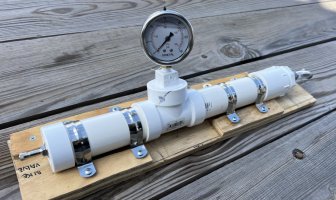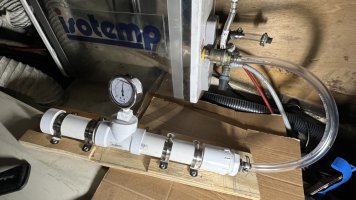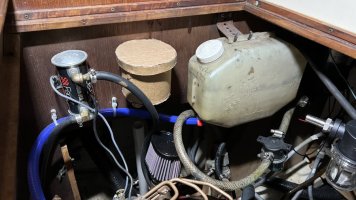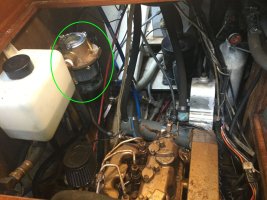Yeah, you could argue that if it's stiff enough, or wire reinforced hose, it's not going to fold over, but it's still cheap insurance.Great idea Ken. They are Marelon elbows, but that's still a good precaution.
You are using an out of date browser. It may not display this or other websites correctly.
You should upgrade or use an alternative browser.
You should upgrade or use an alternative browser.
Coolant Conundrum
- Thread starter Prairie Schooner
- Start date
Prairie Schooner
Jeff & Donna, E35-3 purchased 7/21
. . .
I use a plastic Shur-flow, so I'm not against non-bronze strainers. Mine is located just above the waterline. But, if attaching hoses to plastic hose barbs, just remember that the plastic is the weakest link in the hose-clamp/hose/barb connection. If the plastic barb cracks or deforms and allows the hose to come loose, the upper hose end may still be able to drop/droop below the waterline. So, sometimes I'll safety safety-wire a hose into its elevated position when I attach it to plastic, i.e.,
. . .
I've never heard a convincing argument for the bronze strainers. I mean, they look really cool, Jules Verne Nautilus-y but the bowl is polycarbonate so by the 'weakest link' principle, they're still plastic. And they introduce another metal part into the galvanic action sweepstakes. But, I am open to be convinced otherwise.
Thanks Ken, I'll do some sort of hose anchor like you suggest. We do winterize every year, but it's never really been a hassle to disconnect a hose and stick it in a bucket. I'll reread your description, though. I could be missing something.
Prairie Schooner
Jeff & Donna, E35-3 purchased 7/21
Connecting some dots today and I realized that the ShurFlo threads appear to all be tapered whereas many (all?) of the Marelon threads are strait. On Defender's site there is a warning to that effect which pops up when I go to a Marelon strainer. I didn't look at all of both company's offerings, but it's something to be aware of.Great idea Ken. They are Marelon elbows, but that's still a good precaution.
Marelon offers some clear elbows which are pretty cool if they have the same strength as the black.
Prairie Schooner
Jeff & Donna, E35-3 purchased 7/21

Having some concern about the integrity of the water heater I made a pressure tester. A bike pump connected to a Schrader valve stem is used to pressurize it. A 30 lb. gauge was used to be able to see even a small drop and to keep me from pumping it up too much. I only went to 15 psi.

The coolant loop was all I tested, but thankfully, the pressure held.
Testers with radiator caps are made, and apparently some auto supply stores will rent them. But I couldn't figure out how to test the WH with one of those. It took some doing to make this unit airtight. ~ Out of curiosity, I just looked a little deeper online and found kits that I could have made work. And they are cheaper than I spent in materials. But, it was kind of a fun project. If anyone in driving distance wants to borrow it, let me know.
That looks like the model we installed over 25 years ago or so. Good quality item, imho.Groco ARG-500 raw water strainer in my boat,
Prairie Schooner
Jeff & Donna, E35-3 purchased 7/21

@Nick J @dhill Thanks for the input. - The Vetus 140 would fit in our engine compartment space and I'd gain about 12" of vertical height. The product specs list maximum ambient temperature at 167ºF. I was a little worried that sustained high temperatures might degrade the plastic over time, but realized whenever the engine is running, cool water will be going through the strainer. I'm leaning toward the engine compartment. Likely I'll move the fuel lift pump forward a little and clean up the installation on that overflow reservoir, potable water filter, etc. It's kind of a rat's nest. . . . While I'm in there . . .
Over breakfast today a friend was telling me about his current project - replacing a raw water impeller. The one he took out had little nubs/half blades where the rubber blades used to be and only one blade was still complete. He admitted that he had ignored this pump for several years.
He was looking for lost blades and found very few in the heat exchanged tubes and none in the hoses. He did finally find a bunch of rubber blade bits in the bronze L that was screwed into the outlet side of the pump. Until then he'd been mystified about where all of them could have gone to. He suspects that some small bits went overboard in the exhaust stream. (?)
He was looking for lost blades and found very few in the heat exchanged tubes and none in the hoses. He did finally find a bunch of rubber blade bits in the bronze L that was screwed into the outlet side of the pump. Until then he'd been mystified about where all of them could have gone to. He suspects that some small bits went overboard in the exhaust stream. (?)
Angel D.
Member II
That's some fine engineering Jeff , many times we need to make our own tools. You earn yourself a Pepsi Cola !View attachment 52491
Having some concern about the integrity of the water heater I made a pressure tester. A bike pump connected to a Schrader valve stem is used to pressurize it. A 30 lb. gauge was used to be able to see even a small drop and to keep me from pumping it up too much. I only went to 15 psi.
View attachment 52492
The coolant loop was all I tested, but thankfully, the pressure held.
Testers with radiator caps are made, and apparently some auto supply stores will rent them. But I couldn't figure out how to test the WH with one of those. It took some doing to make this unit airtight. ~ Out of curiosity, I just looked a little deeper online and found kits that I could have made work. And they are cheaper than I spent in materials. But, it was kind of a fun project. If anyone in driving distance wants to borrow it, let me know.

